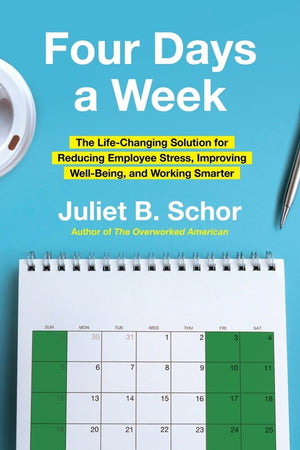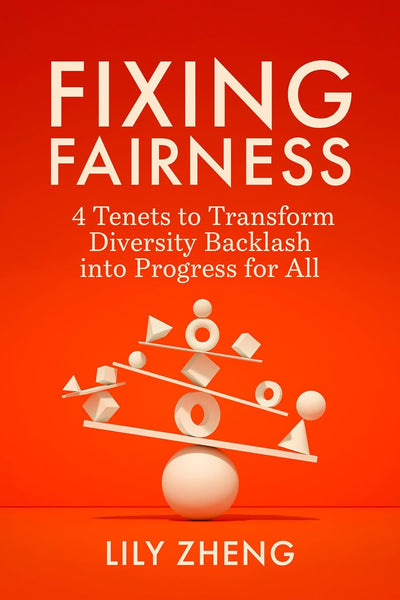The Case for a Four-Day Week
Juliet Schor has been researching companies implementing four-day workweeks since the beginning of 2022 and has testified before the US Senate on the topic. Here, she looks at the progress being made and whether the model can be applied more widely across all types of organizations.
In March 2024, I had the privilege of testifying at a hearing of the Senate Committee on Health, Education, Labor, and Pensions (HELP). Bernie Sanders, the chair, had just introduced a bill to reduce the standard workweek from forty to thirty-two hours, and this was the first Senate hearing on the topic since 1955. Sanders opened the proceedings with a rousing speech reminding his colleagues that for decades productivity gains have gone to people at the top as wages have stagnated and hours have risen. The United Auto Workers president, Shawn Fain, whose union included a thirty-two-hour week in its recent bargaining demands, took umbrage at accusations that working people are lazy and suggested that if anyone fits that description, it’s the “Wall Street freeloaders.” There were absurd moments as well. One witness claimed our research doesn’t accord with “statistical statistics” as she made a number of laughably false claims.
Near the end of the hearing, Chairman Sanders noted that he didn’t expect the bill to become law anytime soon. But he was planting a flag. The buzz in subsequent weeks suggested his strategy was working as the media took notice. Stories included an interview with the hedge fund billionaire Steven Cohen predicting “a four-day week is coming,” a Forbes piece titled “6 Jaw Dropping Clues That the 4-Day Workweek Is Already Underway,” accounts of individual company successes (including organizations from our trials), and articles about the bill—pro and con.
Politicians’ interest in the four-day week makes sense given its enormous popularity. Poll after poll finds that most people prefer a four-day week. The conversation has also started to shift from assessing desirability to feasibility, an indication of momentum. Three-quarters or more tell pollsters they can complete all their work with a four-day schedule. In one survey, the average answer to “how many hours a week are you productive?” was 249.02 thirty-one hours, and 21 percent reported “at most 20.” Other polls have similar findings. It seems that employers are buying the argument. A 2024 KPMG survey of American CEOs found that 30 percent were “exploring organization-wide work schedule shifts such as the 4-day and 4.5-day week.”
Popularity and feasibility don’t necessarily translate into action, however. There are many popular reforms that are stymied for years, or forever. And while companies in our trials have had great success, there are likely only hundreds, not hundreds of thousands, of organizations in the United States on four-day, thirty-two-hour schedules. Yet I am optimistic that we’re going to get there. AI, climate, and a tight labor market are some of the macro forces that should accelerate the transition. There are also signs that we’re organically evolving away from Friday as a workday. But to me, the most compelling argument is that things are playing out very much as they did a hundred years ago, when the United States shifted to a five-day week.
In the 1930s, the impetus to reduce hours of work came from the mass unemployment that was gripping the country. Paradoxically, in the 2020s, a tight labor market is having a similar effect. When employers have trouble attracting and retaining staff, they offer not just higher pay but other benefits that people want. Many workers want a four-day week.
THE LEGISLATIVE PROGRESS
Senator Sanders was of course right that his thirty-two-hour-week bill wasn’t about to be passed into law. However, he is not the only legislator advocating for work-time reduction. Representative Mark Takano had already introduced a similar amendment in the House a couple of times. The Congressional Progressive Caucus, which has almost a hundred members, has endorsed these bills. No country has yet passed a four-day reduced workweek, but some are beginning to experiment. The Spanish were the first to act, in 2021, when they announced a three-year four-day week pilot with government subsidies for the fifth day’s wages. If history is a guide, the companies could count on a 10 percent productivity boost at the beginning, and additional productivity growth through technological innovation over the three-year period, as the subsidies declined. The regional government of Valencia also did its own pilot, which got going earlier than the national one. Not to be outdone by its Spanish neighbors, the Portuguese government sponsored a pilot in 2023, in collaboration with 4 Day Week Global. That one ran like the private sector trials—voluntary participation, no financial incentive—and has had similarly positive results. In 2023, the Scottish government organized a pilot with public sector workers. The Belgians, after passing their four-day-compressed-workweek law, began a pilot program for companies wanting to reduce hours. And beyond these trials, the Spanish government announced its intention to reduce the standard workweek in 2025 from forty to thirty-seven and a half hours. Perhaps this is a first step on its way to thirty-two. There is also movement in eastern Europe. The current Polish government included work-time reduction as an election promise and is deciding between a four-day week and shorter daily hours, with plans to implement the change by 2027. The Slovakian prime minister announced support for a four-day week in January 2024. He referred to a compressed workweek, but Slovak unions are pushing for work-time reduction as well, with the president of the main confederation stating it’s a question no longer of whether but of how.
There’s also activity at state and local levels. In the United States, by mid-2024, more than one hundred legislators across twenty states had taken some kind of action to enable a four-day week. In four states, bills have been introduced to run pilot programs. In a number of states bills have been introduced to reduce the standard workweek, like Senator Sanders’s and Representative Takano’s federal legislation. None have passed yet, but lawmakers aren’t giving up. At the local level, the most common actions have been to move public sector workers to a four-day week. More than 650 school districts in twentyfour states are operating four-day school schedules. Many public sector employees are also on four days with thirty-six or forty hours.
And localities are starting to institute thirty-two-hour schedules. The city of Golden, Colorado, worked with 4 Day Week Global to implement a thirty-two-hour workweek for its police force. It found that response rates to calls increased, overtime costs fell, and it had a 50 percent decline in resignations and retirement. Satisfaction rates with the program have been consistently over 90 percent. Overall, the results have been so positive that the city is now planning to expand it to other departments.
CAN ALL COMPANIES DO IT?
As legislative activity increases, a common question is whether this is a feasible schedule for every employer. Some opponents of government interventions in the labor market have no issue with voluntary actions by companies but draw the line at rules for everyone. One of the GOP themes at the HELP Committee hearing was that this schedule isn’t viable for “people who work with their hands.” The ranking member of the committee, Bill Cassidy of Louisiana, sent me various questions afterward about manual workers, including whether any “assembly line workers” participated in the trials. (Since I calculated that only 0.09 percent of U.S. workers are on assembly lines, that one didn’t feel too relevant.) But there are many industries and occupations for which costlessly going to four days feels difficult.
The issue of manual workers is a bit of a red herring. The manufacturing sector may currently have less wasted time than white-collar, or knowledge, workplaces, but there’s nothing more inherently time wasting about one type of workplace than another. The pace of work, levels of efficiency, and how time is spent are matters of culture, power, and history. Those vary over time within industries and occupations. Labor scholars are well aware that a factory can be riddled with self-defeating practices or hum along at full speed. They know that some industries are much more efficient than others. And manufacturing is the sector that has experienced by far the most productivity growth, which means it should have scope to reduce hours of work without squeezing profits. That’s the beauty of productivity growth. While we don’t have any large manufacturing concerns in our trials, we do have smaller ones, and they have had success with this model.
It also doesn’t make sense to conclude that the kinds of companies that have enrolled in trials are the only ones for which this model will work. Consider the issue of size, and the fact that we have a strong skew toward small companies. That may be because the model will work better for them. It’s also partly due to the setup. But it’s also likely that a change as “out of the box” as giving workers a day off without reducing pay is more daunting for entities that operate like large ocean liners. They need time to shift direction.
And then there’s the issue of selection bias, which in this case is about whether the companies in the trials are different from those that haven’t taken the leap. They surely are, at least in some ways. We didn’t collect data on why organizations were opting to try the four-day schedule. We heard about various reasons—burnout, resignations, the possibility of efficiencies. In most cases, there are probably multiple motivations, which is one reason we didn’t try to track them. But one through line I’ve noticed is that many of these companies have humane work cultures and are led by people who care a lot about their employees. Not all companies fit that bill. However, many do. That makes me think that there are many more organizations that could also successfully adopt this model now, because they’re enough like the early adopters that they could replicate many aspects of their experience.
But for the sake of argument, let’s say it’s true that only some companies can successfully go to four right now. That’s the wrong way to think about whether all companies can. The right questions are, “How many can get there over some reasonable period of time?” and “Will legislation that forces the transition help or hurt?” I think the answers are most can, and legislation will help. It’ll take a while to get a new law, plus it’ll be a phased-in change. Meanwhile, technology is advancing rapidly, which is why Bill Gates, Barack Obama, Jamie Dimon, Steve Cohen, and others say a four- or three-day week is on its way.
The way it will likely happen is that the first group will be followed by others that can replicate their successes. Then another group comes online as the pain point of demanding longer hours than their competitors starts to bite. The laggards will be those that are unable to raise their productivity enough. But that group will likely be outpaced on multiple dimensions, not just working hours. If legislation passes, eventually they’ll have to comply or figure out that they don’t have a realistic business model.
Tracy Smith, the head of HR at Grand Challenges Canada, foresaw this dynamic when we spoke. “I would also say that as an HR person or a people leader … the more companies do [offer the four-day week] the ones that don’t will appear more archaic, more dusty, not as modern. … And so I feel like it’s a mark of innovation, it’s a mark of a philosophy. And if an organization comes across as old-school, I think they’re going to have a harder time in the future attracting folks.”
So when people ask me whether all organizations can do it, my short answer is, not necessarily at the moment, but as it spreads, yes, they will (and will have to) figure it out. After all, that’s what happened with the five-day week.
I’ve been arguing that the four-day week is coming, but that doesn’t mean it will happen automatically. Yes, the forces I’ve written about are coming into play. But it’s individuals who create change. And while there are names history will remember, the world is ultimately transformed by people who don’t make it into the history books. The CEOs I’ve written about. The HR directors who take the idea to senior management. The middle managers who bring a book on the topic to their bosses. The rank-and-file union members who ask their shop stewards to look into it. The entry-level employees who raise the idea at a staff meeting. Social change happens when many people make moves big and small where they live. That’s already happening to some degree. Now it’s time to send the four-day week viral, not just online, but in real life. Every one of us can be a part of this movement.
There’s a lot of gloom and doom these days and many reasons to feel as if the world is falling apart. The four-day week can help us put it back together. As participants in our trials say over and over again, it’s a life changer.
Adapted from Four Days a Week by Juliet Schor published by Harper Business. Copyright © 2025 by Juliet Schor. All rights reserved.
About the Author
Juliet Schor is an economist and a professor of sociology at Boston College and is the bestselling author of numerous books, including The Overworked American, After the Gig, and The Overspent American. She is a fellow of the American Association for the Advancement of Science and has been featured across national and international media, including the New York Times, the Wall Street Journal, Newsweek, People, 60 Minutes, the Today show, and Good Morning America. Her 2022 TED Talk, The Case for a 4-Day Work Week, has been viewed more than three million times.












































